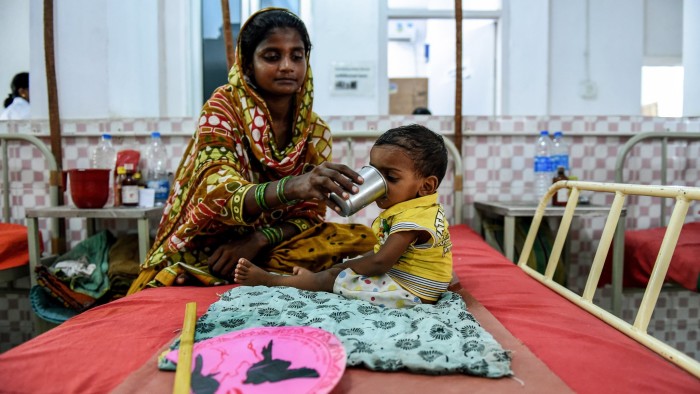India ‘at a turning point’ to tackle pervasive child malnutrition

Roula Khalaf, Editor of the FT, selects her favourite stories in this weekly newsletter.
Santoshi Kumari was an 11-year-old schoolgirl whose impoverished parents depended on state-subsidised rice to keep their family fed. Last year, however, the family lost access to India’s public distribution system, which gives rations of staple foods to the poorest, having failed to link their ration cards to the government’s new biometric identification programme.
Six months later, Santoshi died. It was during a school holiday, when she had no access to another critical source of nourishment, a government scheme that provides midday meals to children in state-run schools. Her parents say their daughter starved to death and that her last words were a plea for rice. Authorities deny she died from hunger, instead blaming malaria, although they confirm that her family had not received food rations for months.
Whatever the cause, Santoshi’s death was a powerful reminder of the pervasive hunger suffered by millions of young Indians, which overshadows their childhoods, compromises their futures and hampers the country’s economic prospects.
India might be touted as an emerging superpower, but millions of its children are still malnourished — the result of unhealthy diets, poor sanitation and their mothers’ own bad health and low social status. Malnutrition threatens not only children’s physical wellbeing but their mental development, too.
“Ninety per cent of our brain develops in the first two years of life,” says Dipa Sinha, a convener of India’s Right to Food campaign. “The nutrition and stimulation you get then determine your learning ability, your future productivity and your long-term physical health.”
For many children, chronic malnutrition begins in the womb, with 20 per cent having a low birthweight. That is the consequence of pervasive nutritional deficiencies in Indian women: about half of women of childbearing age are anaemic.
According to India’s 2015-16 national family health survey, 38 per cent of under-fives (some 50m children) are stunted, meaning their height is significantly below the normal range for their age. That is down from 48 per cent 10 years previously, but is still far higher than in many poorer countries. The survey also stated that 21 per cent of children under five years old are wasted — or significantly underweight for their height — a sign of recent acute hunger.
The results are disastrous for society. Studies have shown that malnutrition and hunger negatively affect children’s behaviour and performance at school, impeding their ability to grasp even basic skills — a situation with severe repercussions for a country that is looking to harness its youthful population to propel the economy. “India has this demographic dividend,” Ms Sinha says, “which we are losing now.”
All told, the World Bank estimates that malnutrition costs India’s economy $12bn a year in lost productivity and higher healthcare spending. New Delhi is not indifferent: for years, the government has funded vast supplementary food programmes, which ostensibly provide extra food to mothers, infants and toddlers as well as the midday meals for schoolchildren. Yet it is unclear how much of this assistance reaches the intended recipients, or whether the most vulnerable members of a family benefit from it. In poorer families, young girls in particular are often allowed less food than their male siblings, and what they do get to eat is often of a lower nutritional quality.
Even when food programmes are functioning well, Ms Sinha says, access to a balanced diet is big challenge for poor families. Handouts mostly take the form of cereals, which provide calories but not enough protein or micro-nutrients for healthy growth.
“We’ve moved away from conditions of starvation, except in very backward areas, but Indian diets are very cereal-based, with very little fruit, vegetables or protein,” Ms Sinha says. “Fruit and vegetables are not cheap, milk is expensive, eggs and meat are expensive.”
Despite the problems, many civil society activists and health professionals believe India is at a turning point. In December, the government approved a national nutrition mission, a $1.4bn, three-year effort to battle malnutrition through better integration and stronger monitoring of various government programmes that affect young children, as well as adolescent girls and mothers. The campaign will be monitored by high-level bureaucrats and is expected to give local officials greater incentive to ensure programmes are carried out properly and help states identify weaknesses.
The mission has set aggressive targets for reduction of stunting, anaemia and low-birthweight babies. It will monitor food programmes and other initiatives, including the national campaign against open defecation, a practice that contributes to malnutrition by encouraging the spread of diarrhoea and internal parasites.
“The minute you really get people paying attention to what is happening on the ground and having reviews, things actually start moving,” says Purnima Menon, a senior researcher at the International Food Policy Research Institute. “You have to put all the pieces together,” she says. “I see quite a bit of energy in the central government towards really starting to roll this out. The road ahead is daunting, but I’m more encouraged now than I have been before.”
Comments